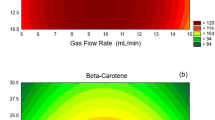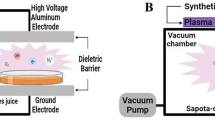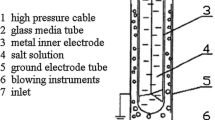Abstract
Pasteurized orange juice is one of the most consumed juices. Although very popular, pasteurization changes the aroma of the juice and produces some off-flavor compounds. This study investigated the effects of cold plasma processing on the aroma and off-flavors of pasteurized orange juice, evaluating if the dielectric barrier discharge (DBD) plasma could improve the aroma and reduce the pasteurized juice off-flavors. Orange juice was subjected to DBD plasma processing operating at several excitation frequencies (50 to 600 Hz). Twenty-four compounds were identified using GC–MS analysis, consisting mainly of terpenoids, alcohols, aldehydes, and esters. DBD plasma induced several chemical reactions changing the volatile profile of the juice. The chemical pathway induced by DBD plasma was discussed and correlated to the changes in aroma and formation of off-flavor compounds. DBD plasma increased the terpenoid and aldehyde compounds that give orange juice its fresh-like characteristics while controlling off-flavors formation.




Similar content being viewed by others
Data Availability
The datasets generated during and/or analyzed during the current study are available from the corresponding author on reasonable request.
References
Achir, N., Pénicaud, C., Bechoff, A., Boulanger, R., Dornier, M., & Dhuique-Mayer, C. (2014). Use of multi-response modelling to investigate mechanisms of β-carotene degradation in dried orange-fleshed sweet potato during storage: From carotenoids to aroma compounds. Food and Bioprocess Technology, 7(6), 1656–1669. https://doi.org/10.1007/s11947-013-1229-y
Agger, S., Lopez-Gallego, F., & Schmidt-Dannert, C. (2009). Diversity of sesquiterpene synthases in the basidiomycete Coprinus cinereus. Molecular Microbiology, 72, 1181–1195.
Amirabadi, S., Milani, J. M., & Sohbatzadeh, F. (2020). Application of dielectric barrier discharge plasma to hydrophobically modification of gum arabic with enhanced surface properties. Food Hydrocolloids, 104, 105724. https://doi.org/10.1016/j.foodhyd.2020.105724
Buttery, R. G., Ling, L. C., & Light, D. M. (1987). Tomato leaf volatile aroma components. Journal of Agricultural and Food Chemistry, 35(6), 1039–1042. https://doi.org/10.1021/jf00078a043
Campelo, P. H., Alves-Filho, E. G., Silva, L. M. A., Brito, E. S., Rodrigues, S., & Fernandes, F. A. N. (2020). Modulation of aroma and flavor using dielectric barrier discharge plasma technology in a juice rich in terpenes and sesquiterpenes. LWT - Food Science and Technology, 109644. https://doi.org/10.1016/j.lwt.2020.109644
Castro, D. R. G., Mar, J. M., da Silva, L. S., da Silva, K. A., Sanches, E. A., de Araújo Bezerra, J., Rodrigues, S., Fernandes, F. A. N., & Campelo, P. H. (2020). Improvement of the bioavailability of Amazonian juices rich in bioactive compounds using glow plasma technique. Food and Bioprocess Technology, 13(4), 670–679. https://doi.org/10.1007/s11947-020-02427-8
Chen, F., Al-Ahmad, H., Joyce, B., Zhao, N., Kollner, T. G., Degenhardt, J., & Stewart, C. N., Jr. (2009). Within-plant distribution and emission of sesquiterpenes from Copaifera officinalis. Plant Physiology and Biochemistry, 47, 1017–1023.
Company, T. G. S. (2019). The good scents company database. The Good Scent Company. Retrieved January, 30th, 2019, from http://thegoodscentcompany.com
Dauben, W. G., Hubbell, J. P., & Vietmeyer, N. D. (1975). Acid-catalyzed rearrangements of humulene. Journal of Organic Chemistry, 40, 479–485.
Deng, J., He, L., Zhao, B., & Chen, Q. (2020). Effects of air relative humidity on spectral characteristics of dielectric barrier discharge plasma assisted combustion reactor. Vacuum, 175, 109189. https://doi.org/10.1016/j.vacuum.2020.109189
Fazzalari, F. A. (1978). Compilation of odor and taste threshold values data. American Society for Testing and Materials.
Ferrara, M. A., Almeida, D. S., Siani, A. C., Lucchetti, L., Lacerda, P. S. B., Freitas, A., Tappin, M. R. R., & Bon, E. P. S. (2013). Bioconversion of R-(+)-limonene to perillic acid by the yeast Yarrowia lipolytica. Brazilian Journal of Microbiology, 44, 1075–1080.
Grosch, W. (2001). Evaluation of the key odorants of foods by dilution experiments, aroma models and omission. Chemical Senses, 26(5), 533–545. https://doi.org/10.1093/chemse/26.5.533
Habibi, F., Ramezanian, A., Guillén, F., Serrano, M., & Valero, D. (2020). Effect of various postharvest treatment on aroma volatile compounds of blood orange fruit exposed to chilling temperature after long-term storage. Food and Bioprocess Technology, 13(12), 2054–2064. https://doi.org/10.1007/s11947-020-02547-1
Hu, C. J., Li, D., Ma, Y. X., Zhang, W., Lin, C., Zheng, X. Q., Liang, Y. R., & Lu, J. L. (2018). Formation mechanism of the oolong tea characteristic aroma during bruising and withering treatment. Food Chemistry, 269, 202–211.
Ito, T., Uchida, G., Nakajima, A., Takenaka, K., & Setsuhara, Y. (2017). Control of reactive oxygen and nitrogen species production in liquid by nonthermal plasma jet with controlled surrounding gas. Japanese Journal of Applied Physics, 56, 01AC06.
Konen, P. P., & Wust, M. (2019). Analysis of sesquiterpene hydrocarbons in grape berry exocarp (Vitis vinifera L.) using in vivo-labeling and comprehensive two-dimensional gas chromatography-mass spectrometry (GCxGC-MS). Beilstein Journal of Organic Chemistry, 15, 1945–1961.
Kumeta, Y., & Ito, M. (2016). Characterization of a-humulene synthases responsible for the production of sesquiterpenes induced by methyl jasmonate in Aquilaria cell culture. Journal of Natural Medicine, 70, 452–459.
Li, F., Chen, G., Zhang, B., & Fu, X. (2017). Current applications and new opportunities for the thermal and non-thermal processing technologies to generate berry product or extracts with high nutraceutical contents. Food Research International, 100, 19–30.
Liu, S. W., Yu, S. T., Liu, F. S., Xie, C. X., Li, L., & Ji, K. H. (2008). Reactions of a-pinene using acidic ionic liquids as catalysts. Journal of Molecular Catalysis A: Chemical, 279, 177–181.
Mantzouridou, F., & Paraskevopoulou, A. (2013). Volatile bio-ester production from orange pulp-containing medium using Saccharomyces cerevisiae. Food and Bioprocess Technology, 6(12), 3326–3334. https://doi.org/10.1007/s11947-012-1009-0
Noguera, N. H., Lima, D. C., Filho, E. G. A., Fonteles, T. V., & Rodrigues, S. (2021). Influence of different non-thermal processing on guava, orange, and tangerine juices and the food matrix effects. Food and Bioprocess Technology, 14(9), 1662–1672. https://doi.org/10.1007/s11947-021-02663-6
Padrayuttawat, A., Yoshizawa, T., Tamura, H., & Tokunaga, T. (1997). Optical isomers and odor thresholds of volatile constituents in Citrus sudachi. Food Science and Technology International, 3, 402–408.
Paixão, L. M. N. M. N., Fonteles, T. V. V., Oliveira, V. S. S., Fernandes, F. A. N. A. N., & Rodrigues, S. (2019). Cold plasma effects on functional compounds of siriguela juice. Food and Bioprocess Technology, 12(1), 110–121. https://doi.org/10.1007/s11947-018-2197-z
Putnik, P., Kresoja, Z., Bosiljkov, T., Jambrak, A. R., Barba, F. J., Lorenzo, J. M., Roohinejad, S., Granato, D., Zuntar, I., & Kovacevic, D. B. (2018). Comparison the effects of thermal and non-thermal technologies on pomegranate juice quality: A review. Food Chemistry, 279, 150–161.
Qian, M. C., & Wang, Y. (2005). Seasonal variation of volatile composition and odor activity value of “Marion” (Rubus spp. hyb) and “Thornless Evergreen” (R. laciniatus L.) blackberries. Journal of Food Science, 70(1), 13–20. https://doi.org/10.1111/j.1365-2621.2005.tb09013.x
Sampedro, F., & Fan, X. (2014). Inactivation kinetics and photoreactivation of vegetable oxidative enzymes after combined UV-C and thermal processing. Innovative Food Science & Emerging Technologies, 23, 107–113. https://doi.org/10.1016/j.ifset.2014.02.007
Silva, R. M., Filho, E. G. A., Campelo, P. H., Silva, F. E. F., Zampieri, D. S., Gramosa, N. V., Fernandes, F. A. N., & Rodrigues, S. (2022). NMR spectroscopy and chemometrics to evaluate the effect of different non-thermal plasma processing on Sapota-do-Solimões (Quararibea cordata Vischer) juice quality and composition. Food and Bioprocess Technology, 15(4), 875–890. https://doi.org/10.1007/s11947-022-02792-6
Takahashi, K., Satoh, K., Itoh, H., Kawaguchi, H., Timoshkin, I., Given, M., & MacGregor, S. (2016). Production characteristics of reactive oxygen/nitrogen species in water using atmospheric pressure discharge plasmas. Japanese Journal of Applied Physics, 55, 07FL01.
TetraPak. (2017). The orange book. Tetra Pak International S.A.
Usami, A., Ono, T., Marumoto, S., & Miyazawa, M. (2013). Comparison of volatile compounds with characteristic odor in flowers and leaves of Nojigiku (Chrysanthemum japonense). Journal of Oleo Science, 62(8), 631–636. https://doi.org/10.5650/jos.62.631
Xiao, Z., Chen, J., Niu, Y., & Chen, F. (2017). Characterization of the key odorants of fennel essential oils of different regions using GC–MS and GC–O combined with partial least squares regression. Journal of Chromatography B: Analytical Technologies in the Biomedical and Life Sciences, 1063, 226–234. https://doi.org/10.1016/j.jchromb.2017.07.053
Yang, G., Liu, Y., Zhou, Z., & Zhang, Z. (2011). Kinetic study of the direct hydration of turpentine. Chemical Engineering Journal, 168, 351–358.
Funding
This work was funded by Conselho Nacional de Desenvolvimento Científico e Tecnológico (CNPq), and Fundação Cearense de Apoio ao Desenvolvimento Científico e Tecnológico (FUNCAP).
Author information
Authors and Affiliations
Contributions
S. Rodrigues: formal analysis, resources, writing—review and editing; F. A. N. Fernandes: conceptualization, investigation, formal analysis, writing—review and editing.
Corresponding author
Ethics declarations
Conflict of Interest
The authors declare no competing interests.
Additional information
Publisher's Note
Springer Nature remains neutral with regard to jurisdictional claims in published maps and institutional affiliations.
Rights and permissions
Springer Nature or its licensor (e.g. a society or other partner) holds exclusive rights to this article under a publishing agreement with the author(s) or other rightsholder(s); author self-archiving of the accepted manuscript version of this article is solely governed by the terms of such publishing agreement and applicable law.
About this article
Cite this article
Rodrigues, S., Fernandes, F.A.N. Effect of Dielectric Barrier Discharge Plasma Treatment in Pasteurized Orange Juice: Changes in Volatile Composition, Aroma, and Mitigation of Off-flavors. Food Bioprocess Technol 16, 930–939 (2023). https://doi.org/10.1007/s11947-022-02976-0
Received:
Accepted:
Published:
Issue Date:
DOI: https://doi.org/10.1007/s11947-022-02976-0




